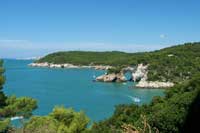Gargano has been selected as one of “The 31 places to go in 2010”
(http://www.nytimes.com/2010/01/10/travel/10places.html?pagewanted=3).
WHY?
Gargano or "Mountain of the Sun" is the cape of the Apulia extending into the Adriatic sea. It is partly mountainous and partly covered by the remains of an ancient forest, Foresta Umbra, the only remaining part in Italy of an ancient oak and beech forest that once covered much of Central Europe as well as the Apennine.
The Gargano, with more than 2000 sq. km of surface, offers many panoramas and beauties from the coasts that alternate beaches of sand and reefs, to the hinterlands with mountains that catch up the 1000 meters, to ancient and beautiful towns. Low hills separating the promontory from the Apennines has given the Gargano a unique geographic identity which made it a sort of biological island that has led to an isolation which profoundly affected both the population and culture.
In the complex the Gargano has a typically Mediterranean landscape, with olive and citrus groves that come down to reach one of the most beautiful sea of Italy. Its nature counts 85 species of spontaneous orchids, the "Foresta Umbra" green heart of the National Park of the Gargano (founded in 1995), its humid zones like the "Oasi Lago Salso" meeting of flamingo and other animals of swamp and two major salt lakes Lesina and Varano. A unique characteristic of the Gargano is the widespread karst phenomena: an erosion process where water, enriched with carbon dioxide, is able to disaggregate and model the limestone, creating dolines, swallow holes, underground cavities, rock bridges and other characteristic phenomena.
The Gargano is also a mix of religion and mystic, with two of the more important world-wide goals for pilgrimage: Monte Sant'Angelo and its basilica of S. Michele Archangel and San Giovanni Rotondo with the grave and the new church of Padre Pio (realized by Renzo Piano). Moreover the Gargano is crossed from the ancient "Sacred Way Longobardorum" (the road the pilgrims covered coming from the northern regions) marked from a remarkable series of sanctuaries set to regular distance.
LINKS:
Parco Nazionale del Gargano: http://www.parks.it/parco.nazionale.gargano/Epar.php
History of the Gargano: http://www.e-gargano.com/eng/gargano.uk.htm
Website Vico del Gargano: http://www.comune.vicodelgargano.fg.it/








